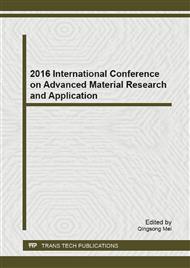p.206
p.211
p.216
p.220
p.225
p.230
p.234
p.241
p.245
One-Step Hydrothermal Reduction and Functionalization of Graphene Oxide with a Modified Diethylene Triamine
Abstract:
Graphene oxide (GO) was prepared by modified Hummer’s method, and reduced by solvothermal method using ethanol as the solvent and modified diethylene triamine (amine curing agent 593) as reducing agent and modifier. The effect of reduction time and temperature on the structure and conductive property of reduced graphene oxide (593-rGO) was investigated by SEM, FT-IR and XRD. The results show that the graphene modified by 593 is obviously improved in dispersibility and sedimentation stability in dichloromethane, as well as in conductivity. The optimal reduction processing is that the mass ratio of GO to 593 is 2:1, the reduction time and temperature is 6 h and 160°C, respectively.
Info:
Periodical:
Pages:
225-229
Citation:
Online since:
January 2017
Authors:
Keywords:
Price:
Сopyright:
© 2017 Trans Tech Publications Ltd. All Rights Reserved
Share:
Citation:


